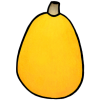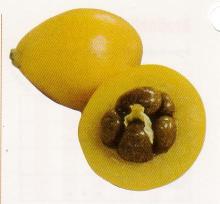Maturity and Quality
Change of skin color from green to yellow to orange is the main index of maturity and ripeness stage. Loquats that ripen fully on the tree taste better than those picked partially-ripe. Ideally, loquats should be harvested when fully yellow but firm.
- Fruit size
- Yellow to orange color intensity and uniformity
- Firmness, absence of defects and decay
- Fully-ripe loquats are very sensitive to physical damage and require very careful handling
- Loquats with higher total sugars content (above 10%) are preferred by most consumers
- Loquats are rich in carotenoids, including provitamin A
Postharvest Handling and Storage
0°C (32°F) for 2-4 weeks, depending on cultivar and ripeness stage.
3-5 and 6-9 ml CO2/kg·hr at 0°C (32°F) and 5°C (41°F), respectively. Loquat is a non-climacteric fruit.
To calculate heat production multiply ml CO2/kg hr by 440 to get Btu/ton/ day or by 122 to get kcal/metric ton/day.
Exposure to ethylene may enhance loss of green color but does not influence flavor quality.
90-95%; packaging in perforated plastic film helps reduce water loss.
0.1-0.3 and 0.2-0.6 µl/kg·hr at 0°C (32°F) and 5°C (41°F), respectively.
Published research is insufficient to make a recommendation.
Disorders
Internal Browning. Internal flesh browning followed by tissue breakdown is enhanced by higher temperatures and longer durations of storage. Elevated CO2 concentrations (>10%) may induce internal flesh browning and skin brown spotting.
Russeting. preharvest skin blemish (brown stripes) that may appear on developing fruit; its severity depends on cultivar, season, and microclimatic conditions. Severely-affected loquats are discarded at the time of preparation for market.
Botrytis cinerea, Colletotrichum gloeosporioides, Pestalotiopsis funerea, and Phytopthora cactoarum have been isolated from loquats, especially those harvested from rainy areas. Control strategies include careful handling, prompt cooling, and maintenance of proper temperature and relative humidity during marketing.




